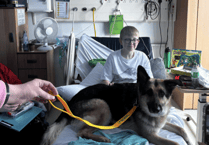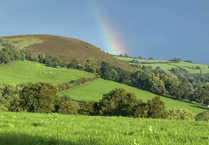FAMILY and friends of a photographer who produced a “defining” image of the Aberfan disaster gathered at a Brecon church on Friday for his funeral.
Godfrey Harris, who was a stalwart of Kensington Baptish Church where his funeral service took place, died aged 85 just before Christmas.
Those who attended his funeral were able to relive tales of his career as a newspaper photographer, which spanned more than 40 years, through the words of Revd Ifor Williams who gave the service.
Godfrey worked for Cardiff-based dailies the South Wales Echo and Western Mail. His most memorable photograph is one of a clock that survived the Aberfan disaster in 1966. It is remarkable because the clock’s hands stopped at the exact time – 9.13am – that a spoil tip of mining waste slid down a hillside and engulfed the town’s primary school and surrounding homes.
The disaster, on October 21, claimed the lives of 144 people, 116 of them pupils at Panteg Junior School.
Incredibly the image was forgotten for decades and was only discovered during a resorting of the Western Mail’s archives around the time of the disaster’s 40th anniversary.
Godfrey, who retired as a photographer in the early 1990s and moved to Llyswen and then to Brecon, took the photograph in the days after the Aberfan disaster when he was assigned by his employers, Thompsons Newspapers, to document how the village was coping in the wake of the tragedy.
Fellow Thompsons photographer Ernie Husson, who now runs a photography business in Llandrindod Wells, was in Aberfan on the day tragedy struck. He said he remembers Godfrey joining him on the assignment.
Mr Husson, who is 74 and 11 years younger than Godfrey, said he has clear memories of working with Mr Harris and was saddened to learn of his death.
“I didn’t see Godfrey on the day of Aberfan. I think he came in the day after. I don’t remember him taking that photograph (of the clock), but obviously when you look back and realise the hands had stopped at the exact time of the disaster you can see it’s significance.
“Godfrey was a good colleague and was always very helpful to me. I left Thompsons shortly after Aberfan to go freelance, but I often bumped into Godfrey on photographic jobs and he always said hello.
“He was an outgoing character which is ideal for a photographer although he was quite reserved about talking about things in his private life. I remember he also took photos of my wedding for the South Wales Echo.”
According to Wales Online, the Western Mail’s website, Godfrey took the photograph on his Rolleiflex roll film camera. Speaking 12 years after his retirement, shortly after the photograph was found, he said: “I saw that alarm clock and it gave the exact time of the disaster. It was in the main street, almost. I couldn’t tell which house it had come from.
“So much had been destroyed. I was over my ankles in mud and slurry. The clock was just there, visible on top of the bricks and debris. The glass was in tact - amazing really.”
He admitted he had moved the clock, which was stained with mud from the disaster, to get the best light. He then placed the clock, which had an ivory-coloured case, back on the rubble.
He said he had probably wiped the clock’s glass so the time recorded by the hands could be seen more clearly.
He added: “There were miners and rescuers everywhere. I was very aware of the human impact all around me. The clock was a tiny part of it (but) it was a symbol of the whole thing, of the moment it happened.”
Godfrey, who died on December 16 last year of pneumonia, began working for the South Wales Echo and Western Mail as a teenager. Starting out as a messenger in 1952, he worked his way up to the position of photographer and later became photographic manager.
He was also present during the investiture of Prince Charles on July 1 1969 in front of 4,000 guests at Caernarfon Castle.
After he retired and moved to mid Wales, Godfrey continued his passion for photography, spending his free time capturing images of the countryside around his home in Brecon.
Christopher, his son who lives in Cardiff, said: “Photography was his main passion, he would always be taking a lot of photos in the countryside in later years. My father was dependable and reliable and honest. What you saw was what you got with him.
“He was quiet but liked a good laugh and was very sociable and gentle. He was great with the kids and helped my son’s own interest in photography, giving his advice.”
His daughter, Jane McClements, who lives near Kidderminster, created a “memory montage” of Godfrey, including some of his photographs, which she put on display in Kensington Baptist Church for his funeral.
She said Godfrey was a regular worshipper at the church and had helped with fundraising when the church needed to raise money to replace its bowed walls. The saga of the church being rebuilt was recounted in the B&R.
Mrs McClements said that her favourite photograph her father took was one of a lollipop lady, Margaret Pritchard, hanging out rugby shirts for the local team in her back garden in Llanhafan in south Wales.
She said: “My dad took some amazing photographs and we’ll all miss him.
“He was quite lonely at the end because my mum had to go into a nursing home, so it was good that he was involved with the church, it meant so much to him.”
Godfrey, who lived at Tilteg, Golwg-y-Fan, Brecon, is survived by his two children and his wife of 61 years, Margaret, who lives in a care home in Llangorse.
He also leaves behind four grandchildren and one great-grandchild, Jacob.




